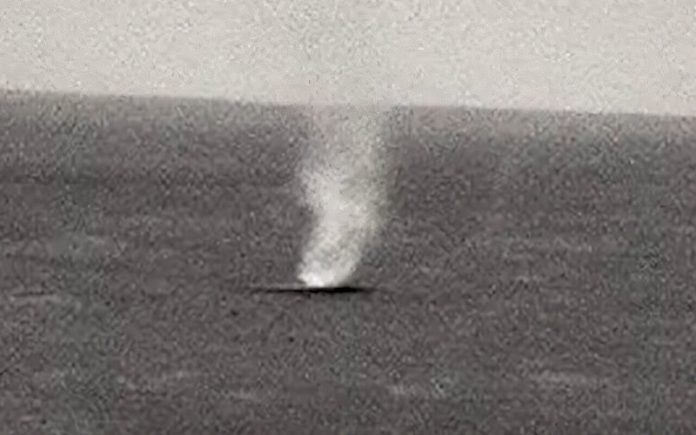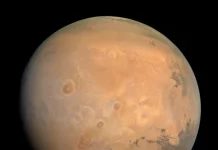
NASA’s Perseverance rover recently captured something amazing on the surface of Mars—a big dust devil swallowing a smaller one.
This rare event was recorded in a short video made from images taken by one of the rover’s navigation cameras while it explored the western edge of Jezero Crater on January 25, 2024.
Dust devils are small, spinning columns of air filled with dust. They are common on Mars and can grow very large.
In the video, the larger dust devil was about 210 feet (65 meters) wide, while the smaller one was only around 16 feet (5 meters) wide.
The rover was about 0.6 miles (1 kilometer) away when it captured the scene.
Two other dust devils can also be seen in the background, adding to the incredible view.
Mark Lemmon, a scientist on the Perseverance team, explained that these spinning mini-tornadoes move around the Martian surface, picking up dust and reducing visibility.
Sometimes, when two dust devils meet, they can either cancel each other out or one can absorb the other. In this case, the larger one overpowered the smaller.
Dust devils form when the surface of Mars heats the air directly above it. The warm air rises and cooler air moves in to replace it, which starts a rotating motion.
As this air rushes into the rising column, it spins faster—just like an ice skater who spins faster when pulling in their arms. The spinning air picks up dust from the ground, creating the visible twister.
Studying dust devils is important because they help scientists learn about Martian weather, including wind patterns and speeds.
According to Katie Stack Morgan, a lead scientist on the Perseverance mission, dust devils are responsible for about half the dust floating in Mars’ thin atmosphere. This dust can affect the climate and even impact the operation of solar-powered spacecraft.
Perseverance is not the first NASA mission to observe Martian dust devils. Back in the 1970s, the Viking orbiters were the first to photograph them. Then in the 1990s, the Pathfinder lander captured images and recorded a dust devil passing overhead. Later, rovers like Spirit, Opportunity, and Curiosity also recorded these fascinating whirlwinds from the Martian surface.
Since it landed in 2021, Perseverance has seen dust devils many times. One of its most memorable recordings came in 2021, when the rover used its microphone to capture the sound of a dust devil for the first time ever.
Capturing these events requires both patience and luck, as scientists can’t predict exactly when or where dust devils will appear. The Perseverance team has learned to monitor the landscape more carefully during times of day when these whirlwinds are more likely to occur.
And as for the dust devil that “ate” its smaller sibling? Mark Lemmon says not to worry too much—it probably disappeared just a few minutes later. Dust devils on Mars are dramatic, but short-lived, usually lasting only about 10 minutes before fading away.



